Text
Exclusive interview with Margaret Johansson.
Below is a copy of an exclusive interview with former resident and relative to one of the missing, Margaret Johansson, recounting her experience following the events of October 21st, 1993.
Nadine: “Margaret, could you tell me how you first came to learn about what happened that day? You mentioned you were away at the time…”
Margaret (nodding): “That’s right. At my sister, Jeannie’s. I’d been staying with her to help out while she tended to Ben—that’s her husband. He had the cancer. Pancreatic. Terrible thing.”
Nadine: “Mind if I ask who called you?”
Margaret (chuckling): “Oh, honey; weren’t no phone call. I found out the same way everybody else did—on the news. It’s strange, you know… seeing your home reduced to a single point in time like that. People nowadays only ever want to talk about what happened. They forget there was a life there before all that.”
Nadine: “That must have been very difficult for you.”
Margaret: “Yes—and no. I hear a lot of the others talking about how difficult it was for them, how the worst part was the ‘not-knowing’. But I tell you, I saw that TV and I just knew.”
Nadine: “Knew?”
Margaret: “That he was gone. I don’t believe in any of that ‘telepathy’ mumbo-jumbo, but I think when two people have spent their entire lives together like Manni and I, when one of them goes, the other just… feels it. You know?”
Nadine: “Sure.”
Margaret: “Of course, that isn’t to say I didn’t still try to call. Hell, I called just about everybody. Hoping to prove myself wrong. Wishing I was wrong.”
Nadine: “You know, one of the things I think often gets overlooked during these conversations is the fact it wasn’t just family people lost. A lot of them lost their homes, too. Can I ask what that process was like for you?”
(Margaret thinks a moment before responding.)
Margaret: “Well, there was a lot of uncertainty in those early days—that’s for sure. I suppose the government did about as good a job as could be expected, given the circumstances.”
Nadine: “You’re talking about Project Haven?”
Margaret (nodding): “That was the government’s name for it, yes. The ‘initiative to find temporary housing for all those displaced by the event’.”
Nadine: “Did they ever reach out to you?”
Margaret: “Sure did. But Jeannie wouldn’t hear of it; what with her being the ‘older sister’ and all. Plus, she still needed help with Ben, so…”
Nadine: “So you moved in?”
Margaret: “That’s right. When Ben went in January, in a weird way, it was kind of like fate; two sisters, both recently having lost their husbands. We were like each other’s carers. Until she got sick too, that is—this was in ’97. Same cancer, too—can you believe that?”
Nadine: “I’m so sorry.”
Margaret (shrugging): “That’s life, isn’t it? I was pretty worried, at first. I mean, Jeannie had left me the house, so I knew I wasn’t going to be homeless. But the government had stopped their monthly stipends by this point, and it was still another year or so until I could declare Manni legally dead and collect his life insurance, and just the thought of going back to work gave me panic attacks…”
Nadine: “Sounds rough.”
Margaret (scoffing): “Right? The worst part was the loneliness. I would just walk around the house all day like a sad ghost. Jeannie’s place is just down from Bolinas Beach, literally right on the water, and most days I would just sit out there on the porch and watch the waves rolling in. I suppose looking back I was probably depressed—which is hardly surprising, given everything that had happened. Anyway, right around then’s when I started to get the feeling.”
Nadine: “The feeling?”
Margaret: “I don’t know how to explain it, exactly. I'd just be walking around the house, and suddenly there’d be this feeling, you know? Not of being watched. More like a… presence. And I knew that it was Manni.”
Nadine: “You mean…”
Margaret (chuckling): “Not like a ghost, if that’s what you’re thinking. I’m not so sure I believe in all that. It was just his presence. The sense of him… it was everywhere. Hell, half the time I’d expect to come downstairs in the morning and find him sitting right there at the counter; that’s how strong it was. I thought I was losing my mind. Until the gifts, anyway.”
Nadine: “Gifts? What do you mean by that?”
Margaret: “They started in the August. I’d find them on the porch; little seashells and other ocean trinkets, all stacked in a pile. At first I thought maybe it was an animal or something—a bird maybe. But the way they were arranged… it felt, I don’t know, purposeful. Like somebody trying to send me a message.”
Nadine: “You mean Manni.”
Margaret: “Right. Every morning for months, I’d open the front door and there they’d be. Just lots of little piles.”
Nadine: “So, back in December, what you said to The Daily Chronicle…”
Margaret (nodding): “Exactly. I’d heard the stories about what they say happened to everybody, how they’d all ‘walked into the sea’. I guess part of me was kind of hoping that was the case, after all. So, I set out to prove it to myself—or at the very least to prove I wasn’t going crazy. I bought cameras. I was determined to catch him in the act.”
Nadine: “And did you? Catch him, I mean?”
Margaret (shaking her head): “He’d move the cameras, or smash them. I tried waiting up, but he never came. It was like he knew. I got so angry; why was he hiding? It seemed so cruel, to make me believe he was still here, but never reveal himself. To keep himself hidden from me.”
Nadine: “Did you ever tell anybody about this?”
Margaret: “I thought about it. But I was worried if I did, he’d stop coming. And I couldn’t stand to be alone again. Not after everything. Anyway, one night I get fed up and just decide hell, if he isn’t going to come to me, I’ll just go to him, instead. So I throw on my robe and wade out into the water. It was storming out, a real typhoon, and I remember watching the streaks of lightning overhead as I took those first tentative steps into the Pacific, the frigid waves lapping at my bare ankles and making me gasp. Needless to say, I was pretty drunk. I almost always was in those days—but you probably guessed that already. Anyway, I wade in a little, then a little more, until all of a sudden it’s up to my thighs, and just as I’m thinking maybe this isn’t such a good idea after all, a wave comes out of nowhere and knocks me down. I try to push myself up, but I’m all turned around, on account of all the rolling and the darkness, and I remember thinking this is it, you know, this is how I’ll die. And do you know what? I was okay with it. I’m an old woman. I’ve had my time. So I continue to roll, and I guess at some point I must have blacked out, as next thing I know I’m waking up back on the couch at Jeannie’s, drenched to the bone. I sit up, look at the floor, which I see now is just one giant puddle. I follow it quickly outside to the porch, then down to the sand, where I see footprints leading back towards the ocean. I look out over the waves, and while I can’t be positive, I think I can just make out what looks like the shape of a man staring back at me from the water.”
Nadine: “Manni.”
Margaret (wiping away tears): “Yes.”
Nadine: “Not to be unkind, but are you sure you couldn��t have simply imagined it? It was dark, after all.”
Margaret: “Oh, sure. I could have. Grief plays tricks, after all. Really, I like to think it was his way of letting me know that everything was going to be all right, that I didn’t need to feel alone anymore.”
Nadine: “Do you still get gifts?”
Margaret: “Not so much these days. But I still feel him. He’s out there, my Manni. And I know that one day we’ll be together again.
#horror#mystery#portnewickmystery#unsolved mysteries#camp here and there#cryptidcore#ghost town#nightvale#stranger things#wtnv#welcome to nightvale#weird town#world building
1 note
·
View note
Text

A still from The Holloway Footage.
This symbol, crudely painted onto the flaked wooden siding of a house, was one of several found by the documentary crew during their exploration of Port Newick. The origins and meaning of the symbols remain unknown, adding to the enigma surrounding the town's fate.
#mystery#horror#portnewickmystery#unsolved mysteries#cryptidcore#ghost town#nightvale#stranger things#speculative fiction#world building#worldbuilding#alternate reality game#weird town#wtnv#welcome to nightvale#writers on tumblr#twin peaks#the x files#x files
2 notes
·
View notes
Text

*Pictured: A flyer from one of many boat tours that arose in the wake of the Port Newick WikiLeaks Report.*
Below is an excerpt from the chapter ‘Aftermath: Part 2,’ taken from journalist Nadine Ames’ controversial book, Vanishing at Port Newick: An Unofficial Account of America’s Most Mysterious National Disaster.
THE RESPONSE TO THE revelation of the existence of The Holloway Footage was almost unilateral outrage from all sides. The government, in keeping with tradition, denied any prior knowledge of the film’s existence, while simultaneously going to great lengths to debunk its existence as a work of fiction.
As with any great tragedy, there were many who attempted to cash-in on the renewed interest the town had acquired. Almost immediately, unofficial boat tours were set-up, where members of the public could tour the waters surrounding the perimeter line in the hopes of “seeing a Hybrid”, unbridled capitalism once again thriving in the face of tragedy.
Despite the events captured in The Holloway Footage, there were also many who likewise attempted to sneak into the town, forcing the government to enforce tighter security measures as well as increased fines for those caught attempting to circumvent the town’s quarantine.[1]
In the months following its release, as one might expect, the footage from The Holloway Footage was analysed fervently by experts and internet sleuths alike, each hoping to make claims as to its validity. As of the time of this writing, no official conclusion has been reached, though general consensus is that, while fantastical at times, it has not been tampered with, nor has any computer-generated imagery been used.
Grant Sinclair, a professor of digital forensics at Stanford University, had this to say:
"After conducting a comprehensive analysis using the latest in digital forensics technology, we found no evidence of post-production manipulation in The Holloway Footage. The continuity of the metadata, the consistency of the lighting and shadows, and the absence of any compression artifacts that would suggest re-encoding or editing lead us to conclude that the footage is authentic. While this does not verify the events depicted, it does significantly bolster the case that what we're seeing is a genuine, unaltered recording from the time of the incident."
Despite Sinclair’s assertions, not everyone shared this sentiment.
Dr. Lara Henley, a professor of cognitive psychology specializing in visual perception at Yale University, offered this viewpoint:
"While the technical analysis might not show signs of digital manipulation, that alone doesn't verify the authenticity of the events depicted. Our minds are highly susceptible to deception, and under certain conditions, can fill in gaps or perceive things that align with our beliefs or fears. Given the high-stress environment, it's plausible that the filmmakers experienced a sort of shared delusion or misinterpretation of natural phenomena.”
Among those likewise critical of the footage’s events were several political pundits, each hoping to levy the footage’s release as ammunition to further their political agendas, alongside several high-profile names, most notably famed director and writer Guillermo Del Toro, who called it, quote, “a fucking good time”, and “like something I’d write”.
Also of note was the footage’s influence on pop culture.
Hybrid Death March, a progressive metal band from Sweden that emerged in 2011 in the wake of the Port Newick WikiLeaks Report drew both attention and controversy after the release of their self-titled debut album's lead single, "Siren Song," in which relatives of the missing townsfolk criticized the lyrics, calling them “grossly insensitive”.
Sample lyrics from "Siren Song":
"Echoes of a siren’s call, in the depths where shadows fall,
Lost voices rise and beckon, Hybrid Death March’s reckon,
Whispers of a silenced town, in the night they all went down,
Their secrets kept in ocean’s keep, where the lost ones call out from the deep.”
Perhaps the best example of the Port Newick Incident’s effect on pop culture, however, would come in the form of the BBC’s 2021 three-part mini docuseries “The Holloway Tapes”. The series, starring venerable actors Helen Mirren and Gary Oldman as two journalists tasked with investigating the events surrounding the filmmakers’ disappearance, was a global sensation, garnering an impressive 11-million viewers at its height. While praised for its acting and sensitivity around the source material, many still criticized the series for its speculative approach to the more unverified aspects of the footage, once more prompting the question of exactly where the line is in regards to fiction crafted from real events.
As one might expect, The VFV also had much to say.
Appearing on Ellen, Margarite Lenneman, a spokesperson for Voices for the Vanished and former native of the town, made an impassioned plea once again for full disclosure from the government, citing the revelation of The Holloway Footage as “the perfect time” to come-clean about the true nature of the ongoing government presence in the area.
Not to be forgotten also, of course, were the plethora of conspiracy theories that emerged in the wake of The Holloway Footage’s reveal. Like the ones before them, these new theories, while bombastic at times, were similarly not without some credence. What’s more, they now all shared a common through-line: a conspiracy by the government to conceal the existence of entities currently existing within the quarantine zone.
[1] In a possible testament to human nature, many influencers were caught attempting to sneak past quarantine, resulting in a trend on social media that lasted right up until the government’s eventual crackdown.
#mystery#horror#portnewickmystery#unsolved mysteries#camp here and there#cryptidcore#ghost town#nightvale#stranger things#weird town#wtnv#welcome to nightvale#wikileaks#alternate reality game#five nights at freddy's#the x files#x files#writers on tumblr#arg horror#arg game#arg project#found footage
0 notes
Text
An excerpt from "Earth Matters," blog of environmental scientist and author Dr. Linda Allen, speculating on the origins of the events in Port Newick:
As all reading this will know, we live in an era marked by unprecedented environmental degradation. Industrial pollution, deforestation, and climate change are not just abstract concepts; they are daily realities with tangible impacts on ecosystems.
Now, as we approach the thirty-first anniversary of the Port Newick National Tragedy, recent evidence suggests that the events of October 21st, 1993, may have been more than just a mass disappearance, or, as is the government’s official stance, an “environmental catastrophe.” Rashes that spread throughout the town, originating (allegedly) out of the water; could it be that Port Newick was the first warning shot in what some are calling "Mother Nature's Retribution"?
Or, put simply, could this be Mother Nature finally fighting back?
#mystery#horror#portnewickmystery#unsolved mysteries#cryptidcore#ghost town#nightvale#stranger things#camp here and there#speculative fiction#worldbuilding#alternate reality game
3 notes
·
View notes
Text
An excerpt from an interview with witness David Rosen, regarding an incident at the Port Newick perimeter line.
Interview Conducted By: Detective Michael Torres
Recording Officer: Officer Julie Mann
#mystery#horror#portnewickmystery#unsolved mysteries#camp here and there#cryptidcore#ghost town#nightvale#stranger things#weird town#wtnv#gravity falls#welcome to nightvale#puzzle#wikileaks#alternate reality game#five nights at freddy's
2 notes
·
View notes
Text
*Exclusive message from 'Daedalus...'*
"Daedalus", the elusive whistleblower who was instrumental in the distributing of Port Newick info during the WikiLeaks scandal, has reached out to us here at PNM with an exclusive:
Can you solve the cipher?
Keyword: 'DAEDALUS'
Cipher text: Iirg tsy vrcypeyn sw tmqyfld.foq/5ajht8wm
Hint: Vigenère
Share your findings with #PortNewickMystery. Once decoded, the message will guide you to a crucial document link. Good luck!
#mystery#horror#portnewickmystery#unsolved mysteries#cryptidcore#camp here and there#ghost town#gravity falls#nightvale#stranger things#weird town#wtnv#welcome to nightvale#puzzle#unsolved mystery#wikileaks#cipher#alternate reality game#five nights at freddy's
8 notes
·
View notes
Text
"I'd catch him zoning out. A little at first, then more often as the days went by. He said he could hear the sea calling to him. Like an actual voice, beckoning him to the water..."
A quote from former resident Margaret Johansson on her husband Manni’s behavior in the days leading up to the Vanishing.
Margaret, who left Port Newick just days before the tragic event to attend to personal matters, remains steadfast in her assertion that he is still alive.
#horror#mystery#portnewickmystery#unsolved mysteries#camp here and there#cryptidcore#ghost town#gravity falls#nightvale#stranger things
6 notes
·
View notes
Text



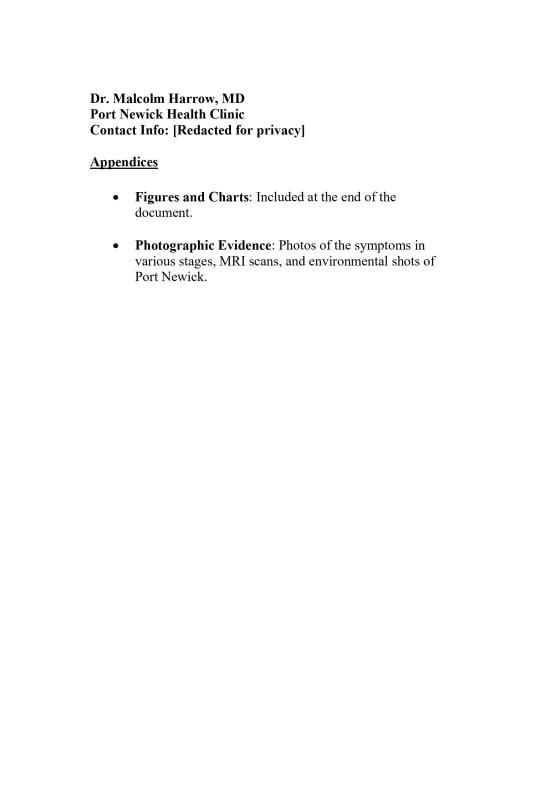
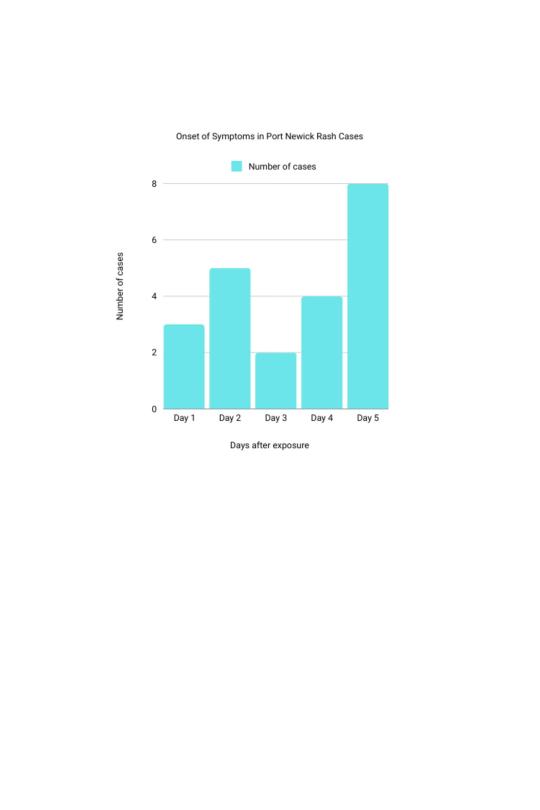
A copy of an alleged emergency medical report, filed by one Dr. Malcom Harrow to the Marin County Health Department, dated two days prior to the Vanishing.
Revealed to the public during the WikiLeaks fiasco of 2008, it is believed this report was filed following an outbreak of an as-of-yet unidentified contagion that spread through the town in the days and weeks leading up to the events of October 21st.
While the contents of the report remain unverified, its existence has become a "smoking gun" for conspiracy theorists who have consistently alleged that the disappearance of the townsfolk was supernatural in origin.
#horror#mystery#unsolved mysteries#portnewickmystery#camp here and there#cryptidcore#ghost town#gravity falls#nightvale#stranger things#escapist#wtnv#welcome to nightvale#night vale#five nights at freddy's#twin peaks#x files#the x files#world building#worldbuilding#weird town#abandoned#abandoned town#abandoned things#weird core#arg horror#arg game#arg project
5 notes
·
View notes
Text

'The Sea Monster of Stinson Beach,' as imagined by seven-year-old Jamie Teller from Stinson Beach, who claimed to have seen the creature from her bedroom window one foggy evening. This drawing, among others by local children, has become emblematic of the enduring mysteries that the WikiLeaks documents only deepened, and further supports the idea that whatever happened in Port Newick thirty years ago is spreading.
Image provided courtesy of the Teller family archive, submitted to the Marin County Historical Society, 2010.
#horror#mystery#unsolved mystery#portnewickmystery#camp here and there#cryptidcore#nightvale#gravity falls#ghost town#unsolved mysteries#escapist#wtnv#welcome to nightvale#night vale#twin peaks#x files#the x files#stranger things#worldbuilding#world building#weirdcore#weird town
7 notes
·
View notes
Text

A snippet from John Ryder’s popular radio show, ‘Mystery Waves Radio,’ taken on the day of the Vanishing. For many, this was their first introduction to the Port Newick National Disaster. The show, which would go on to cover the situation in Port Newick extensively, played an integral part in its eventual evolution into pop-culture myth.
#horror#mystery#unsolved mysteries#portnewickmystery#weird town#gravity falls#wtnv#nightvale#camp here and there#twin peaks#x files#cryptidcore#stranger things#worldbuilding#speculative fiction#writers on tumblr
5 notes
·
View notes
Text
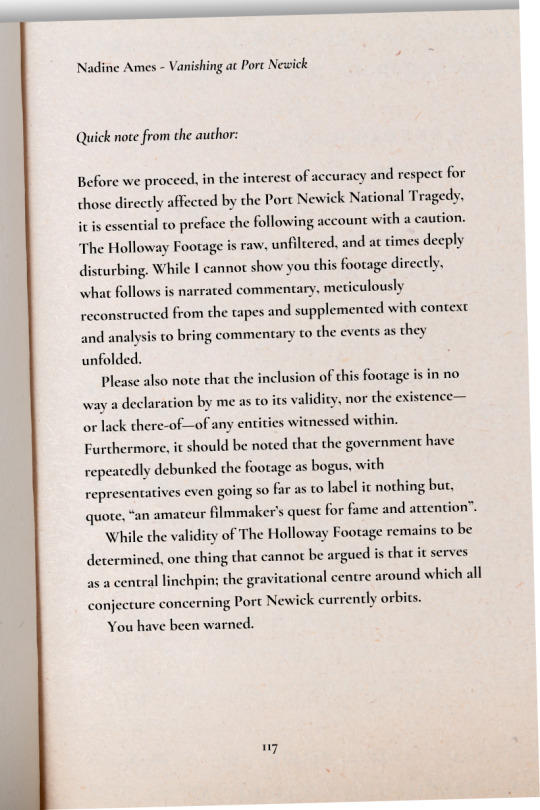
A scan of a page from Nadine Ames' controversial book, Vanishing at Port Newick: An Unofficial Account of America’s Most Mysterious National Disaster, offering a warning about the subsequent chapter's unsettling contents.
It should be noted that the government have since banned all broadcasting of the footage, citing public safety concerns. However, heavily edited snippets of the film can be still found online via YouTube and other video-sharing platforms.
#mystery#horror#unsolved mysteries#portnewickmystery#weird town#gravity falls#wtnv#nightvale#twin peaks#camp here and there#x files#cryptidcore#stranger things#escapist#speculative fiction
1 note
·
View note
Text

An excerpt from the chapter ‘The WikiLeaks Report,’ taken from journalist Nadine Ames’ controversial book, Vanishing at Port Newick: An Unofficial Account of America’s Most Mysterious National Disaster.
BY THE LATE 2000S, interest in Port Newick and its continued quarantine had died down significantly, in large part due to the lack of any new information, but also due to extraneous events taking precedent in the public’s mind—most notably the war in Iraq and the US’s much-televised war on terror.
However, all that would change in 2008 with the release of new details during the now-infamous WikiLeaks scandal. These documents, comprising communication logs, internal reports and email chains, suggested not just negligence, but deliberate concealment of facts by officials at the highest level.
As one might expect, the fallout was immediate and explosive. Media outlets seized upon the story, reigniting a media frenzy around Port Newick that had not been seen since the immediate aftermath of the initial disappearance. Online forums and social networks were ablaze with speculation, wild theories, and calls for full disclosure from the government.
However, even in light of this new information, while it was clear that the government’s official explanation for the town’s fate was a facade, it was still unclear as to exactly what had transpired that had seen all of the residents of Port Newick effectively fall off the face of the earth.
It wouldn’t be until late-November of 2009, with the release of The Holloway Footage, that we would get our first answers.
1 note
·
View note
Text

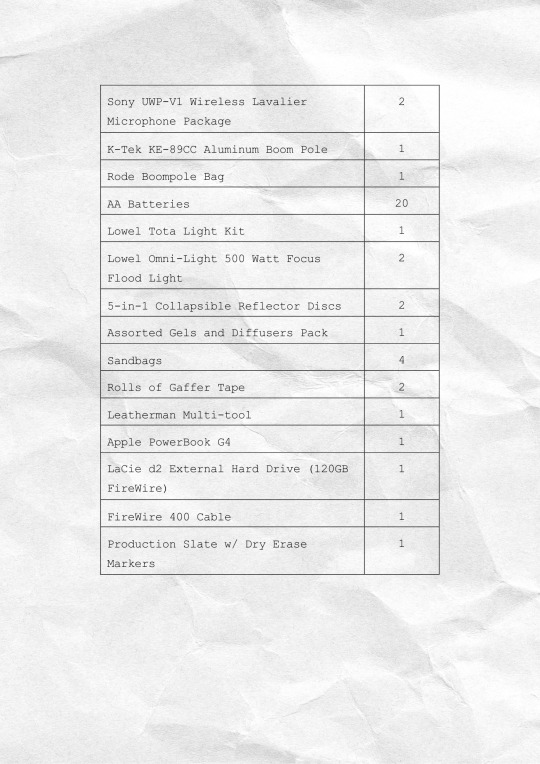

A copy of the UCLA lending form unearthed by Redditors in 2010 following the reveal of the Holloway Footage.
While it remains to be determined as to exactly when commencement of the documentary officially began, we can discern from the UCLA’s equipment lending form that the equipment necessary for the filming of the documentary was rented from the university by Tom on September 12th, two days before the footage recorded at the motel, implying they were at the very least in the preliminary stages.
#mystery#weird town#unsolved mysteries#gravity falls#wtnv#nightvale#twinpeaks#camp here and there#x files#cryptidcore#stranger things#it#pennywise#escapist#world building#writers on tumblr
3 notes
·
View notes
Text

A Reddit post on r/PortNewick, referencing a common conspiracy theory alleging these supposed creatures are in fact the townsfolk themselves, now transformed into human-fish hybrids. While fantastical, these claims are not without some credence (see WikiLeaks).
#mystery#unsolved mysteries#weird town#gravity falls#wtnv#nightvale#twin peaks#camp here and there#x files#cryptidcore#stranger things#escapist#world building#worldbuilding
2 notes
·
View notes
Text
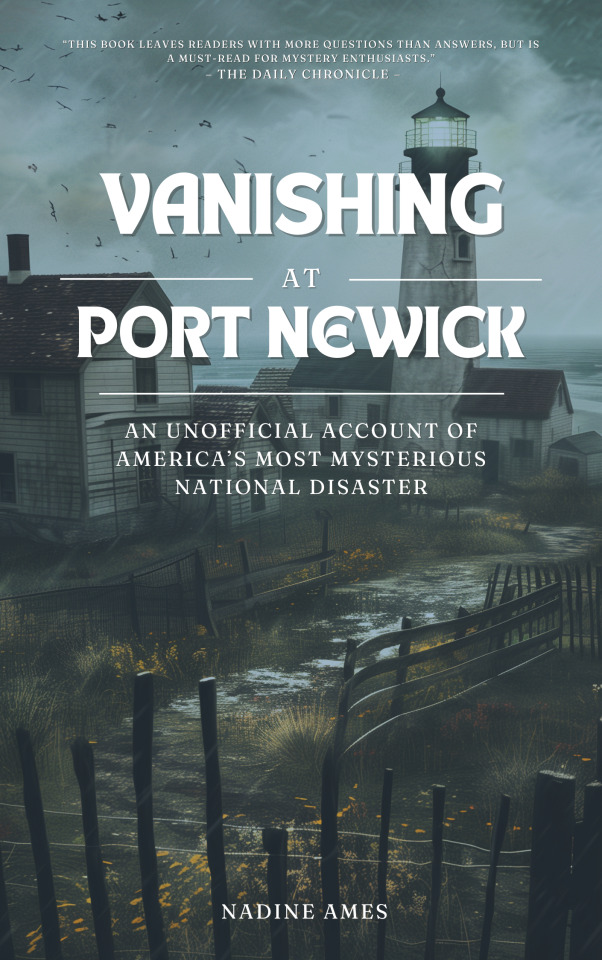
An excerpt from the chapter ‘Aftermath,’ taken from journalist Nadine Ames’ controversial book, Vanishing at Port Newick: An Unofficial Account of America’s Most Mysterious National Disaster.
IN THE WEEKS THAT followed, news was fleeting. Any new updates were met with immediate doubt and speculation—something that only served to increase the public’s confusion. Was this a missing persons’ case? A biohazardous outbreak? Fanning the flames of this confusion were the repeated refusals from government to provide any concrete answers as to the location or condition of the townsfolk, or in fact any confirmation as to the initially reported mass disappearance.
Over the next few months, the government’s hold on the town only grew. The quarantine zone, erected virtually overnight and spanning a total of 15 square miles (including a four-mile stretch into the Pacific), continued to stand as a glaring question mark, acting as a symbol of the public’s mistrust.
In January of 1994, after months of almost no news, the government would release an official statement as to what exactly had occurred.
In their Port Newick Commission Report, it stated:
“On the morning of October 20th, a freighter carrying toxic cargo capsized in the waters just outside of Port Newick and dumped its payload into the Pacific”, and furthermore, that “the coastal winds had blown the resulting poisonous gas cloud inland, killing everybody in the town and creating an unprecedented environmental disaster.”
This “environmental disaster”, as the report would go on to elaborate, involved catastrophic damage to both fauna and wildlife, and was the catalyst for the government’s lockdown of the town and its surrounding waters.
These reports, however, starkly contrasted those of the first responders to the town, each of whom reported no signs of an environmental catastrophe.[1] Perhaps even more concerning, while the report contained elaborate accounts of the measures taken to contain the so-called spill and the subsequent environmental recovery efforts, it inexplicably lacked any mention of a “mass disappearance”. This prompted intense outcry from many of the family members of those still missing—many of whom had been on the ground at the time of the event and refused to accept the government’s claims of an environmental disaster.
As questions continued to mount, one thought took center-stage; where were the bodies? And furthermore, if the government had the bodies, why weren’t they releasing them?
A report released by Dr. Helena Forsyth, the Director of Public Health Safety for the PNNIRT (Port Newick National Incident Response Team) in March of that same year had this to say:
“In the wake of the environmental disaster precipitated by the capsizing of the freighter and the subsequent release of its hazardous cargo, comprehensive assessments by our health and safety teams determined that the toxicological impact posed a significant risk not only to the immediate environment but also to public health. Specifically, the nature of the toxins involved necessitated stringent biohazard containment protocols. Unfortunately, this includes the remains of those tragically lost. Releasing the bodies without thorough decontamination processes—which, given the circumstances, are not feasible—would pose an unacceptable risk of secondary contamination to the families and the community at large. It is with heavy hearts that we enforce these measures, prioritizing the safety and well-being of the entire population.”
This explanation, however, was likewise met with much skepticism, and as the months turned into years—and in the absence of any new information—theories began to emerge. Whist many of these theories were baseless and somewhat fantastical in nature, they nonetheless served as a great reminder of the public’s ability (and indeed, willingness) to “fill in the gaps” in lieu of any new information. Talk of “alien abductions” and “government experiments gone awry” dominated public discourse for the next several years, much to the upset of many of the family members of the missing, all of whom were still no closer to understanding what exactly had become of their loved ones.
In late 1995, these same family members would establish what would later go on to become the Voices for the Vanished; a self-funded advocacy group run by relatives of the missing townsfolk hoping to pressure the government into providing full disclosure on the events of ’93, as well as further explanation as to the government’s continued presence in the town.
In their first official statement to the public, kindergarten teacher Kathy Grier, lead organiser and sister to one of the missing, had this to say:
"It has become increasingly apparent that the government believes we cannot handle the truth. As family members, we feel it is our right to know what happened to our loved ones, which is why we have formed the Voices for the Vanished; not just to demand answers, but to ensure that our loved ones are never forgotten. We want the truth, however difficult it may be, and we will not be placated by half-truths and misdirection."
As the years progressed, the VFV became a focal point for media attention and public support. They organized annual vigils, set up information booths at community events, and engaged in peaceful protests outside government buildings. Their activities brought them into occasional conflict with local authorities, but also garnered them a following among conspiracy theorists and investigative journalists alike, who were drawn to the story's unresolved and mysterious nature.
In addition to advocating for transparency, the VFV also sponsored independent investigations. They hired private investigators and teamed up with environmental scientists to conduct their own tests in the waters around the quarantine zone, looking for any signs of the alleged toxic substances. Their findings, which consistently contradicted the official government reports, were published in a series of press releases and public documents that further fueled public debate.
One significant moment came in 2001 when Dr. Marina Gilbert, a marine biologist who had been quietly researching the ecological impacts around the quarantine zone, came forward with her findings at a VFV-organized conference in Seattle, Washington. She presented a detailed critique of the government's environmental impact statements, highlighting discrepancies and questioning the absence of data on the toxic cargo's composition:
"Based on the samples we've analyzed from the periphery of the quarantine zone, the levels and types of toxins do not correspond with those typically associated with industrial cargo spills. Furthermore, the recovery of local marine life does not align with the patterns of recovery from other known toxic spills, indicating that—whatever happened there—it was not toxicological in nature.”
This statement ignited a fresh wave of media coverage and led to calls for a re-examination of the entire Port Newick incident. The push from the VFV and their persistence in questioning the official narrative laid the groundwork for the eventual WikiLeaks revelation in 2008, which would expose a series of classified communications suggesting that the government had known more about the conditions in Port Newick than they had ever admitted publicly.
[1] While unsubstantiated, the lack of subsequent commentary from these individuals only serves to bolster public speculation that their current silence is a result of strict NDAs having been forced upon them by the United States government. These claims remain unconfirmed, however.
1 note
·
View note
Text
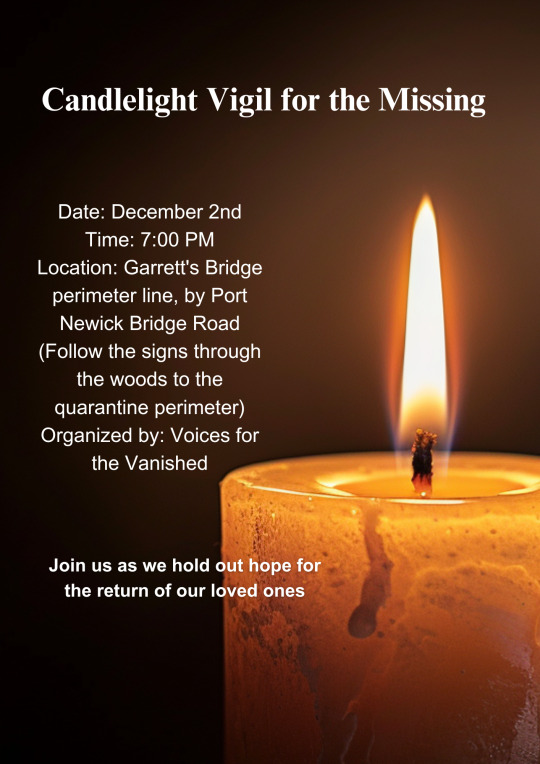
A recent flyer for a vigil held at the Port Newick Perimeter Line
On December 2nd, Voices for the Vanished organized a candlelight vigil at Garrett’s Bridge perimeter line. The community gathered to hold out hope for the return of their loved ones who mysteriously vanished. The continuation of these annual vigils, despite the passage of time, showcases the public's continued desire for the truth.
#PortNewick #Vanishing #CandlelightVigil #VoicesForTheVanished #Community #Hope
1 note
·
View note
Text
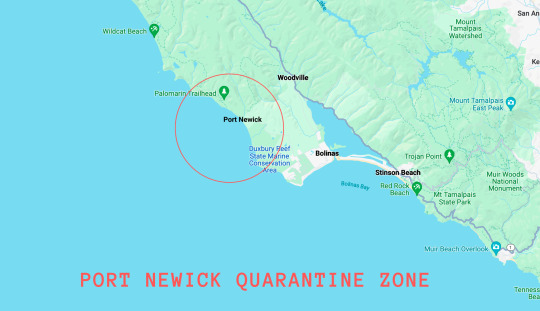
An excerpt from the chapter ‘The Vanishing,’ taken from journalist Nadine Ames’ controversial book, Vanishing at Port Newick: An Unofficial Account of America’s Most Mysterious National Disaster.
WHILE ESTABLISHING AN EXACT timeline of events leading up to the discovery of the tragedy in Port Newick remains difficult due to lack of information, we are however able to determine an approximate breakdown of events immediately following the discovery. This breakdown, established through witness accounts, contemporaneous press coverage and official police records, offers a small glimpse into the chaos and confusion that ensued in the forty-eight hours following the discovery.
0-6 Hours After Discovery
On the morning of October 21st, 1993, at approximately 6:30am, delivery driver for West Coast Deliveries John Grady arrives in Port Newick to deliver that morning's post. He finds the streets eerily deserted, but no obvious signs of foul play. By 7:00am, with still no signs of anyone and unease setting in, he attempts to hail people by knocking on the doors of several nearby shops, all of which go unanswered.
At roughly 7:45am, he pays a visit to the Marin County Sheriff's Department to file a report, citing, “something strange” happening in the town of Port Newick.[1]
At approximately 8:30 am, two hours after the initial discovery, Deputies Mark Lester and Frank Mosley, responding to John Grady's report, arrive in Port Newick, finding it, as Deputy Lester would later report to the Marin Independent Journal, “quiet as the grave”. They perform a preliminary lap of Main Street, finding no activity. In mirroring Grady’s response, they begin banging on doors and calling out to any potential nearby locals, all of which go unanswered.
Expanding their search onto Beacon Street, they peer through the windows of several of the houses, finding in many of them signs of sudden departure; television sets still on; plates of half-eaten food. Curiously, upon further inspection they also find several of the houses with their doors standing ajar, indicating whomever had exited had done so in a hurry.
By 9:00 AM, no doubt realizing the gravity of the situation, Deputy Lester radios for additional units.
As the morning progresses, with word quickly spreading about the town’s fate, the small contingent of first responders grows. Local volunteers, off-duty officers, and eventually more formal search and rescue teams are called in to assist in the investigation. A makeshift command centre is set up at the town's community centre, now serving as a hub for the growing number of concerned relatives and friends gathering, seeking any news of their missing loved ones.
Despite the comprehensive search efforts, by noon, there is still no sign of the town's inhabitants, prompting then-sheriff Thomas Caldwell to officially declare a missing persons emergency for the town. State and federal authorities are contacted and briefed on the situation.
The afternoon brings a flurry of activity as news crews arrive and the story breaks nationally. The initial reports of a deserted town morph into headlines speculating about the cause, from potential gas leaks to more sinister theories. The national spotlight on Port Newick grows, drawing in onlookers, amateur sleuths, and government officials alike.
By evening, the decision is made at higher levels to quarantine Port Newick. Federal authorities, alongside state police, quietly begin the process of cordoning off the town. Official statements prepare the public for the news of a "potential hazardous event," with promises of further information as the situation is assessed.
6-12 Hours After Discovery
By sundown, Port Newick is no longer just a local concern, but a national enigma. Federal agents alongside biohazard teams arrive under the cover of dusk. The shift from civilian-led searches to military-grade intervention is almost imperceptible to the onlookers gathering beyond the town limits, yet it marks a significant escalation in response.
The roadblocks, initially manned by local police, now lie under control of the National Guard, redirecting traffic and initiating what would soon be known as the quarantine zone. Helicopters hover above, sweeping the town with searchlights, while teams on the ground move methodically from building to building in a coordinated search effort that extends into the early morning hours.
A strict no-fly zone is imposed over Port Newick and the surrounding areas. Media are pushed back to a newly established perimeter, as official communications are limited to terse statements regarding an ongoing investigation. The scarcity of information only fuels wild speculation.
Sheriff Caldwell, in an effort to appease growing public panic, organizes a late-night press conference, asking for calm while they search for answers.
As the night deepens, the quiet despair of the morning turns to a restless unease. Families huddle together in the temporary shelter of the community centre, holding onto hope as the hours pass with no news. Officials filter in and out, offering little in the way of reassurance or answers.
The initial groundwork for what will soon become a longstanding government operation is laid down in these crucial hours. Documentation is scarce, but reports of strange equipment being transported into the town, and the erection of more permanent barriers, solidify the reality that the situation is far from ordinary.[2]
By the end of the 12-hour mark, Port Newick is transformed from a quaint seaside town to a fortified enigma, its story just beginning to unfold. The quarantine zone is now fully enforced, with a strict curfew for the surrounding areas. The government's grip on the situation tightens, as do the hearts of all who watch and wait for any word on the missing residents.
12-24 Hours After Discovery
The dawn of October 22nd brings no reprieve. The once routine activities of the Marin County coastline are halted as the impact of Port Newick's silence ripples outwards, much to the chagrin of many of the locals. The morning's news cycles continue to churn with talk of the situation in Port Newick, but fail to offer any further insight. Citing health and safety concerns, the family members of the missing are relocated from the community centre to another location outside of the quarantine zone.
An emergency meeting is called by the Governor of California, Pete Wilson, addressing the state and the nation, reiterating the need for calm and patience as they await further news.
It is at around this time that the first rumors of a potential disease outbreak begin to surface as a possible cause, but are quickly dismissed by state health officials. Yet, without a credible alternative, the vacuum of information is filled with increasing fear and anxiety.
The day continues with an eerie quietude, the investigation and searches being conducted behind the veil of the quarantine. News reports speak of the CDC and other agencies' involvement, further complicating the public's understanding of events.
At sunset, the families and friends of Port Newick's residents hold a candlelight vigil at the quarantine perimeter line.[3]
By the 24-hour mark, the narrative is no longer controlled by local authorities or the community of Port Newick but has become a matter of national security.
24-48 Hours After Discovery
As dawn breaks on October 23rd, the mystery of Port Newick's fate remains tightly sealed behind the government-imposed quarantine. The federal response has shifted into a strategic containment and information management operation. The surrounding communities wake to a heightened military presence and the sobering reality of the town's isolation.
Throughout the day, federal officials assert control, emphasizing a potential biological hazard as the focus of their concern. This narrative serves dual purposes: it justifies the stringent quarantine measures and redirects public speculation away from the more troubling and unexplainable aspect of the entire town's sudden vacancy.
Governor Pete Wilson, in coordination with federal agencies, holds a press conference to announce the formation of a specialized task force. The term "biohazard event" is carefully used, framed within the context of precautionary measures rather than confirmed crisis.
In neighboring towns, life is tinged with unease. Schools remain closed, local businesses struggle, and residents are caught between seeking normalcy and grappling with the growing dread of the unknown. The quarantine zone, now fully fortified, stands as a stark reminder of the severity of the situation, with only authorized personnel allowed entry.
Around 2:00pm, attempts by locals to breach the quarantine in search of answers are met with firm resistance, underscoring the government's commitment to maintaining the perimeter at all costs. The incident, though minor, fuels further discontent and suspicion among the public, prompting an official statement from the Incident Public Information Officer. The carefully worded briefing emphasizes ongoing investigations into a "potential health risk" and the importance of public cooperation.[4]
By evening, the narrative of a possible biohazard continues to be disseminated through official channels. Lights within the quarantine zone and the distant sound of activity serve as the only indicators of the ongoing operations. The official stance remains one of caution and control, with assurances of transparency and updates as the situation evolves.
Yet, beneath the surface of these official statements, questions remain unanswered. The absence of any direct mention of the residents' whereabouts, coupled with the vague references to a biohazard, only adds to the public's frustration and fear. Theories proliferate in the absence of concrete information, and the mystery surrounding Port Newick deepens.
As the 48-hour mark since discovery passes, Port Newick has transitioned from a small fishing and trade community to a closely guarded government operation.
By the end of the first week, and in an attempt to quell growing discontent from the public, the federal government announces the establishment of an official inquiry into the events at Port Newick, promising a thorough and transparent investigation into the causes and circumstances surrounding the town's fate.
This inquiry, to be led by a panel of experts from various fields, including epidemiology, disaster response, and environmental science, aims to provide a definitive account of what actually transpired. The government pledges full cooperation with the panel, ensuring access to all relevant data and authority to call upon witnesses as needed.
To some, this move is regarded as a sign of progress. For others, skepticism prevails, with many questioning not only the independence of the panel, but the willingness on the part of the government to provide full disclosure.
As the promise of the inquiry circulates through the news, Port Newick's empty streets remain silent under the watchful eyes of the guards, acting as a haunting reminder of the myriad mysteries that lie just beyond reach.
[1] A full breakdown of this report can be found at the Marin County Public Records Office.
[2] According to on-site witnesses, this equipment included portable barriers, hazmat containment units, and advanced communications gear. These reports were later corroborated by leaked government emails published as part of the Port Newick WikiLeaks Report in 2008, which detailed the logistical preparations for establishing the quarantine zone.
[3] Footage from this vigil would go on to dominate press coverage of the incident for the next several months, acting as a visual embodiment of the families’ hope for answers.
[4] A copy of the official statement released by the Incident Public Information Officer is available at the Marin County Public Records Office.
#ARG (Alternate Reality Game)#Mystery#horror#Thriller#stories#creepy#alternate history#unsolved mysteries#PortNewick#paranormal#unexplained#creepypasta#alternate reality game#found footage#speculative fiction#scifi
1 note
·
View note